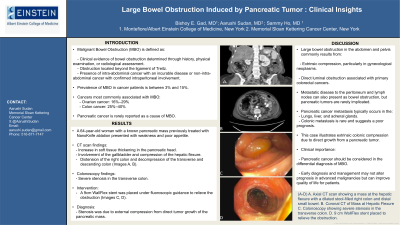Sunday Poster Session
Category: Colon
P0273 - Large Bowel Obstruction Induced by Pancreatic Tumor: Clinical Insights
Sunday, October 27, 2024
3:30 PM - 7:00 PM ET
Location: Exhibit Hall E

Has Audio

Aarushi Sudan, MD
NYC Health + Hospitals/Jacobi
New York, NY
Presenting Author(s)
Bishoy E. Gad, MD1, Aarushi Sudan, MD2, Sammy Ho, MD, FACG3
1Montefiore Medical Center, Albert Einstein College of Medicine, Bronx, NY; 2NYC Health + Hospitals/Jacobi, New York, NY; 3Montefiore Medical Center, New York, NY
Introduction: Malignant Bowel Obstruction (MBO) is defined as (i) clinical evidence of bowel obstruction (via history, physical, and/or radiological examination), (ii) bowel obstruction beyond the ligament of Treitz, and (iii) diagnosis of intra-abdominal cancer with an incurable disease, or a non-intra-abdominal primary cancer with the clear intraperitoneal disease. The prevalence of MBO among cancer patients ranges from 3% to 15%, predominantly associated with advanced stages of malignancies.The primary cancers most frequently leading to MBO include ovarian (16%- 29%) and colon cancer (25%-40%). Pancreatic cancer has rarely been implicated in the development of MBO.
Case Description/Methods: A 64-year-old woman with a history of pancreatic mass treated with NanoKnife ablation presented with weakness and poor appetite. A CT scan revealed an interval increase in ill-defined soft tissue thickening in the pancreatic head involving the gallbladder and compressing the hepatic flexure with distension of the right colon and a decompressed transverse and descending colon. (Images A, B). The patient underwent a colonoscopy and severe stenosis was found in the transverse colon. A 9cm WallFlex stent was placed under fluoroscopic guidance to relieve obstruction. (Images C, D). Stenosis was concluded to arise as a result of external compression of the colon due to direct tumor growth.
Discussion: Tumors of the abdomen and pelvis often present as large bowel obstruction due to extrinsic compression, as seen in gynecological neoplasms, or direct endoluminal obstruction with primary colorectal cancers. Although metastatic disease to the peritoneum and lymph nodes can also present with bowel obstruction, pancreatic masses are rarely implicated. Pancreatic tumors typically metastasize to the lungs, liver, and adrenal glands, with colonic metastasis being rare and indicative of a poor prognosis. This case describes extrinsic colonic compression from direct growth of a pancreatic tumor, highlighting the importance of considering pancreatic cancer in the differential diagnosis of MBO. While timely diagnosis and appropriate management may not change the prognosis for advanced malignancies, they can significantly improve the quality of life for affected patients.

Disclosures:
Bishoy E. Gad, MD1, Aarushi Sudan, MD2, Sammy Ho, MD, FACG3. P0273 - Large Bowel Obstruction Induced by Pancreatic Tumor: Clinical Insights, ACG 2024 Annual Scientific Meeting Abstracts. Philadelphia, PA: American College of Gastroenterology.
1Montefiore Medical Center, Albert Einstein College of Medicine, Bronx, NY; 2NYC Health + Hospitals/Jacobi, New York, NY; 3Montefiore Medical Center, New York, NY
Introduction: Malignant Bowel Obstruction (MBO) is defined as (i) clinical evidence of bowel obstruction (via history, physical, and/or radiological examination), (ii) bowel obstruction beyond the ligament of Treitz, and (iii) diagnosis of intra-abdominal cancer with an incurable disease, or a non-intra-abdominal primary cancer with the clear intraperitoneal disease. The prevalence of MBO among cancer patients ranges from 3% to 15%, predominantly associated with advanced stages of malignancies.The primary cancers most frequently leading to MBO include ovarian (16%- 29%) and colon cancer (25%-40%). Pancreatic cancer has rarely been implicated in the development of MBO.
Case Description/Methods: A 64-year-old woman with a history of pancreatic mass treated with NanoKnife ablation presented with weakness and poor appetite. A CT scan revealed an interval increase in ill-defined soft tissue thickening in the pancreatic head involving the gallbladder and compressing the hepatic flexure with distension of the right colon and a decompressed transverse and descending colon. (Images A, B). The patient underwent a colonoscopy and severe stenosis was found in the transverse colon. A 9cm WallFlex stent was placed under fluoroscopic guidance to relieve obstruction. (Images C, D). Stenosis was concluded to arise as a result of external compression of the colon due to direct tumor growth.
Discussion: Tumors of the abdomen and pelvis often present as large bowel obstruction due to extrinsic compression, as seen in gynecological neoplasms, or direct endoluminal obstruction with primary colorectal cancers. Although metastatic disease to the peritoneum and lymph nodes can also present with bowel obstruction, pancreatic masses are rarely implicated. Pancreatic tumors typically metastasize to the lungs, liver, and adrenal glands, with colonic metastasis being rare and indicative of a poor prognosis. This case describes extrinsic colonic compression from direct growth of a pancreatic tumor, highlighting the importance of considering pancreatic cancer in the differential diagnosis of MBO. While timely diagnosis and appropriate management may not change the prognosis for advanced malignancies, they can significantly improve the quality of life for affected patients.

Figure: (A-D) A. Axial CT scan showing a mass at the hepatic flexure with a dilated stool-filled right colon and distal small bowel. B. Coronal CT of Mass at Hepatic Flexure C. Colonoscopy showing severe stenosis in the transverse colon. D. 9 cm WallFlex stent placed to relieve the obstruction.
Disclosures:
Bishoy Gad indicated no relevant financial relationships.
Aarushi Sudan indicated no relevant financial relationships.
Sammy Ho indicated no relevant financial relationships.
Bishoy E. Gad, MD1, Aarushi Sudan, MD2, Sammy Ho, MD, FACG3. P0273 - Large Bowel Obstruction Induced by Pancreatic Tumor: Clinical Insights, ACG 2024 Annual Scientific Meeting Abstracts. Philadelphia, PA: American College of Gastroenterology.
